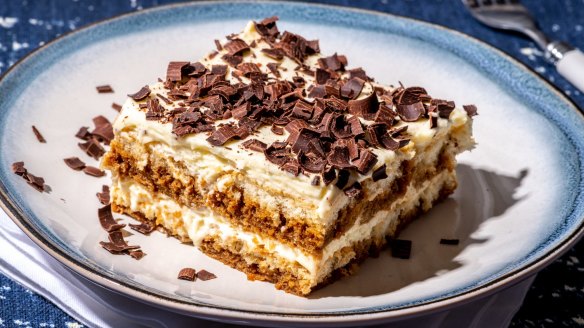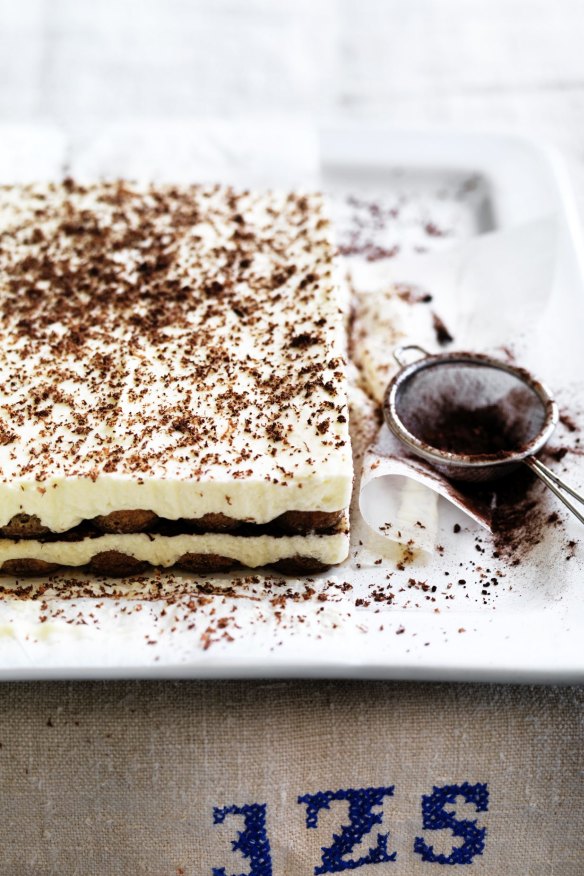Why tiramisu is the perfect dessert for these times (and how to make it)
Tiramisu is a polarising dessert. Mention it, and people may squeal with delight or recoil in disgust – there's no in-between. In The Oxford Companion to Italian Food, author Gillian Riley is unsparing, "At its best, in small quantities, a fine dessert, otherwise a gross, overrated indulgence."
With all due respect, Ms Riley, I disagree.

Tiramisu, which is loosely translated from Italian as "pick-me-up", can be transcendent, restrained and, dare I say, cloud-like when made properly. It should taste sweet, creamy, slightly boozy and bitter all at once.
"When tiramisu is really good, the result is bigger than the sum of its parts," says chef Brooks Headley of Superiority Burger in New York. He first learned how to make it at Galileo Restaurant in Washington. Headley still makes tiramisu the same way he was taught: packaged savoiardi (ladyfinger biscuits, which he prefers over homemade sponge,) mascarpone, raw egg yolks, a little dark rum and cocoa powder.
"The slight bitterness of coffee, gentle dairy flavour from mascarpone – it's a good balance between luxury ingredients and the stuff you can get at a grocery store," Headley said. "I find the process of making tiramisu therapeutic: soaking the savoiardi and then stacking them in a [dish]."

The dessert's origin story is hazy, but its roots date back to the '60s in Treviso, Italy. It wasn't until the 1980s, however, that it took New York by storm. Soon trendy restaurants around the world – Italian or not – offered it.
Tiramisu became such a part of the zeitgeist, it got its own mention in Nora Ephron's 1993 movie, Sleepless in Seattle, when the protagonist, played by Tom Hanks, about to dip his feet back in the dating pool, asks his friend, played by Rob Reiner, for advice. "Tiramisu," Reiner says randomly after giving him a few pointers. "What is tiramisu?" Hanks asks. "You'll find out," Reiner replies. "Some woman is going to want me to do it to her, and I'm not going to know what it is!" Hanks exclaims.
Tiramisu's popularity became a double-edged sword. As more and more restaurants served it, many began cutting corners.
The dessert has so few ingredients that when even one isn't good quality, it shows – ending in a cloying confection.
We've all had bad tiramisu.
Its basic components are universally accepted. Tiramisu is made with ladyfingers (or sponge cake) dipped in – or brushed with – espresso often spiked with liquor, and layered with a whipped, sweetened mascarpone-yolk mixture.
Everything else is up for debate.
Some argue the egg yolks must be gently cooked into a zabaglione, while others, like Headley, insist on raw yolks. There are versions that fold whipped cream or beaten egg whites into mascarpone as a lightener (and likely to keep the whites from being wasted). There's also debate about what kind of alcohol to add – rum, brandy, marsala or others – and how much (I like mine boozy, but that could also be the times we're living in). Ina Garten and Giada De Laurentiis prefer dark rum, while Nigella Lawson has used anything and everything from Bailey's to Frangelico. A friend's mother who emigrated from Italy in the '70s uses Kahlua, while New York-based Contra and Wildair chef Fabian von Hauske adds bitter amaro to his.
"I found the unpopularity of the dessert is part of the appeal," von Hauske told me, "and I wanted to eat something that reminded me of my childhood." He prefers to use firmer sponge cake and makes the portions to-order but agrees it's a dessert that does especially well when allowed to sit so the flavours mingle.
Centrolina pastry chef, Caitlin Dysart, has found the dessert suits the times we're in.
"We've been hesitant to put it on the menu, because people expect that from an Italian restaurant, and it felt cliche, whereas we wanted to explore a vast variety of Italian cuisine," the chef said. "But we've been making it a lot since covid, when we switched to take-out only. It travels and keeps very well. I've found that people are really going for those comfort foods and love it."
As for tiramisu's longevity, Dysart believes it has stood the test of time because, if made well, it's at once elegant and comforting.
"I always think I don't like it," she says, "and then I eat a piece, and really enjoy it."
Through trial and error, I've come up with my favourite version. I lighten the mascarpone-yolk mixture with beaten egg whites and just a touch of whipped cream. I dial back the sugar and lightly dip the ladyfingers in a strong, bitter espresso-rum concoction to cut through the richness of dairy and egg and balance the sweetness. While some prefer to drench the savoiardi in the coffee, I prefer a moistened biscuit that retains its texture beside the creamy layers, making me want to eat bite after bite.
Of all the alcohol I've tried, dark rum has turned out to be the best complement, tempering the sweetness and adding lovely caramel notes to the coffee. I finish it with a flourish: shavings of bittersweet chocolate, though I also like using high-quality unsweetened cocoa powder.
Then, I have to wait patiently for my tiramisu to set – which just might be the hardest part of making this dessert.
Tiramisu
We prefer the flavour of quality dark rum, but brandy can be another traditional choice of alcohol here. We also prefer the dessert on the boozier side as it cuts through the richness of the dairy and eggs and makes it taste more interesting, but feel free to use the amount you like best.
INGREDIENTS
- 480ml strong coffee/espresso, at room temperature
- 120 to 180ml good dark rum (or brandy, if preferred)
- 4 large eggs, separated and at room temperature
- 100g sugar
- ¼ tsp salt
- 500g mascarpone*
- 120m cream
- about 48 ladyfingers* (savoiardi)
- shaved bittersweet chocolate, for garnish
METHOD
- In a wide, shallow bowl, combine the coffee with rum or brandy and set aside.
- In a large bowl, using a hand mixer on medium-high speed, beat the yolks with the sugar and salt until pale and creamy, about 3 minutes. Add the mascarpone and beat on medium-high speed until combined and billowy.
- In a medium bowl, using a hand mixer on high speed, beat the cream until soft peaks form, about 2 minutes. Gently fold the whipped cream into the egg yolk mixture.
- In another medium bowl, using a hand mixer on low speed and gradually increasing to high, beat the egg whites until soft peaks form, 2 to 3 minutes. Gently fold the egg whites into the mascarpone-yolk mixture until combined.
- Dip each ladyfinger into the coffee mixture for just a few seconds and line the bottom of a 22cm x 30cm x 5cm dish. Repeat with more ladyfingers to form a single layer on the bottom of the pan.
- Spread half of the mascarpone mixture evenly over the top. Repeat with the remaining ladyfingers and mascarpone mixture. Smooth out the top and cover with plastic wrap. Refrigerate for at least 6 hours and preferably overnight.
- When ready to serve, generously dust the top with the chocolate shavings, then slice and plate. Serve cold or chilled.
Serves 8-12
Tips: Tiramisu can be stored in an airtight container for up to 4 days in the refrigerator or for up to 3 months in the freezer.
*Mascarpone, an Italian soft cheese, and ladyfinger biscuits can be found at well stocked supermarkets or Italian grocers.
The Washington Post
The best recipes from Australia's leading chefs straight to your inbox.
Sign up- More:
- How to